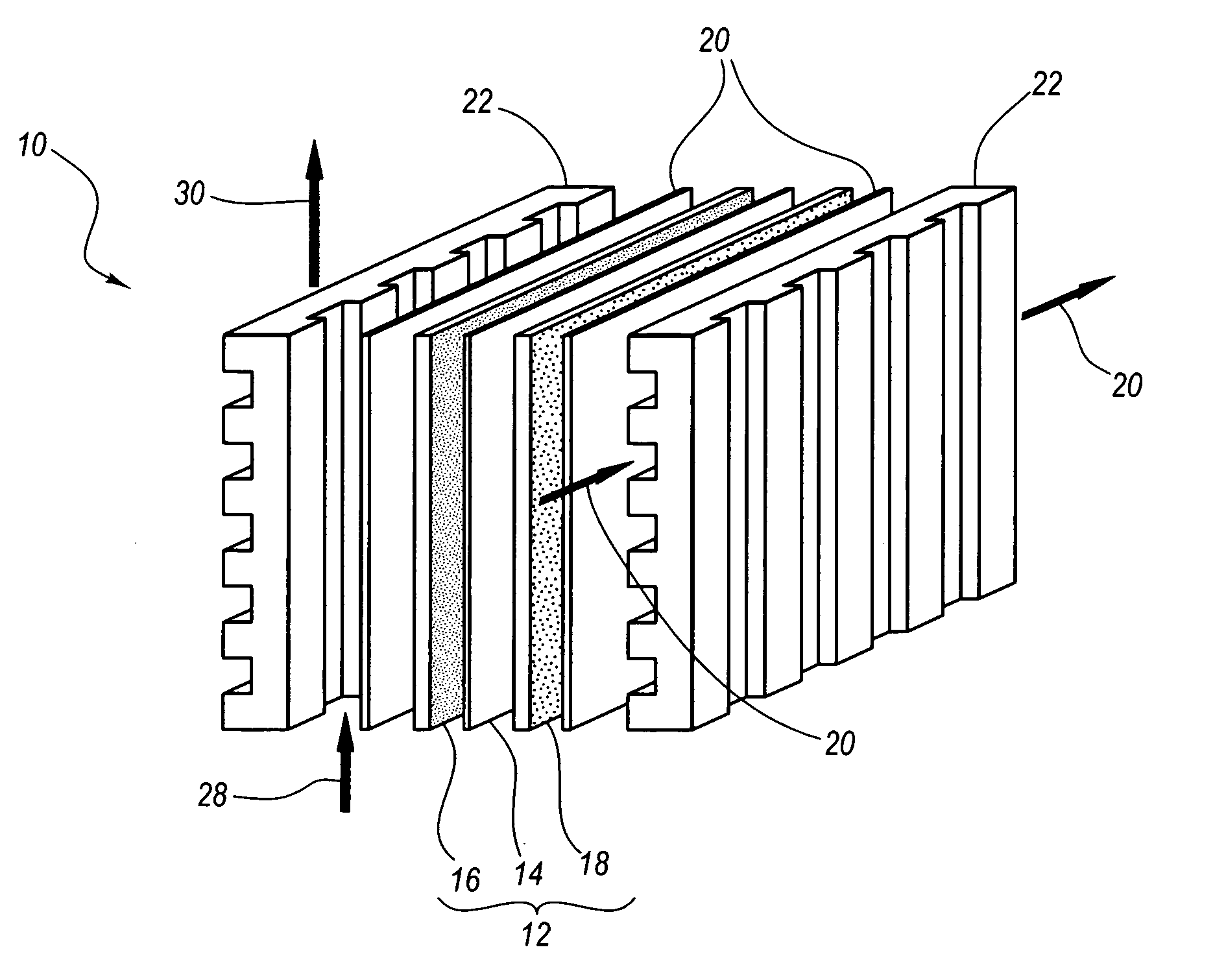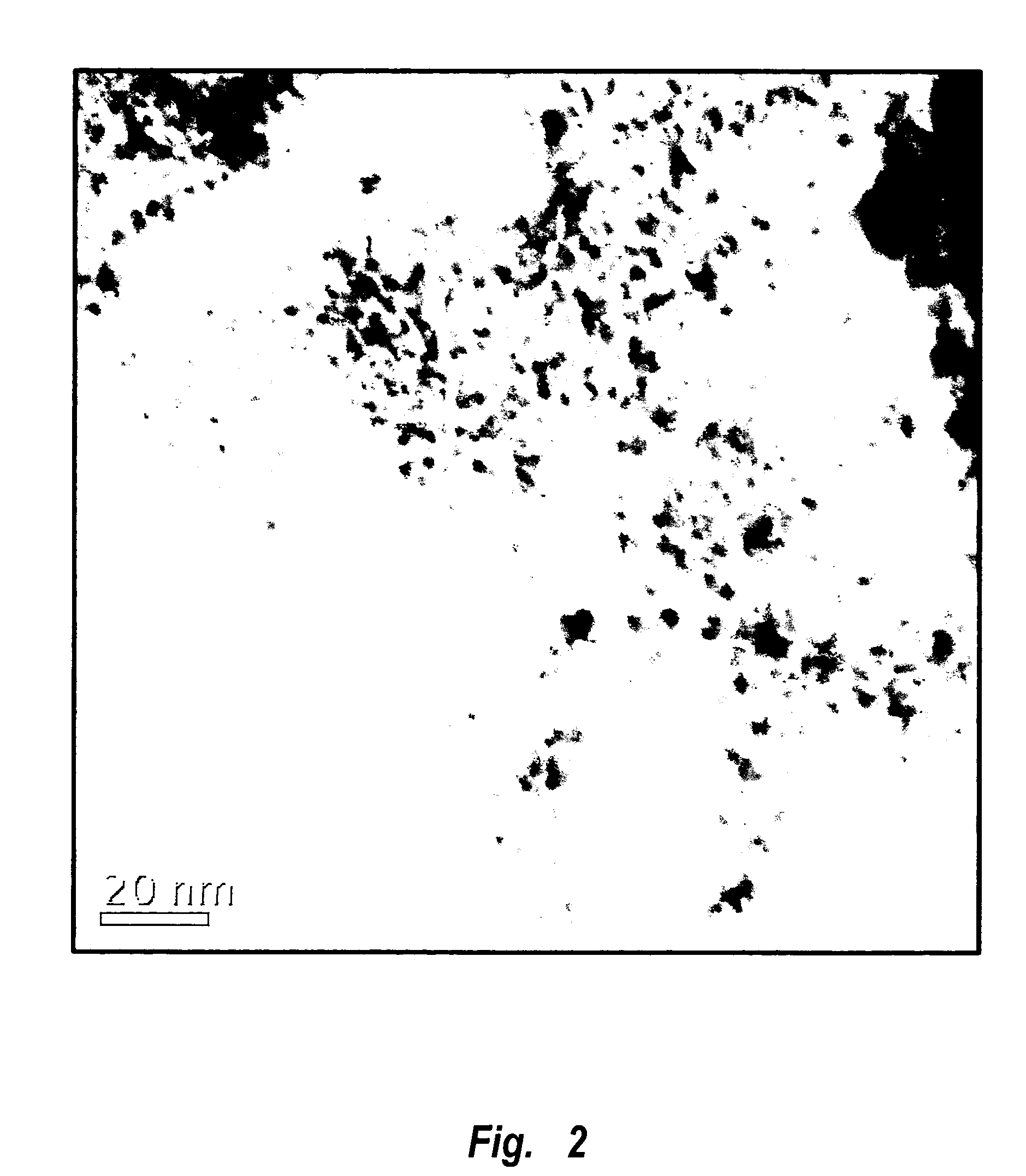Methods of manufacturing fuel cell electrodes incorporating highly dispersed nanoparticle catalysts
a technology of catalysts and fuel cells, applied in the field of manufacturing fuel cell electrodes, can solve the problems of very small catalyst particles formation, and achieve the effect of improving the stability of catalysts during us
- Summary
- Abstract
- Description
- Claims
- Application Information
AI Technical Summary
Benefits of technology
Problems solved by technology
Method used
Image
Examples
example 1
Pt / C Catalyst Preparation
[0070] A 40 wt % Pt / C was prepared using platinum as active component, a conductive support, and glycine as the dispersing agent. The catalyst was prepared using the following steps and concentrations:
[0071] (1) 300 mg of Ketjen carbon black was placed under vacuum for 1.0 hr and then impregnated with 40 ml water.
[0072] (2) Solution A was prepared by mixing 783.7 mg of an aqueous solution of H2PtCl6 containing 25.52 wt % Pt into 30 ml water.
[0073] (3) Solution B was prepared by dissolving 77 mg of glycine in 30 ml water to provide a 1:1 mole ratio of anchoring agent to metal.
[0074] (4) Solution C was obtained by refluxing a mixture of solution A and solution B for 1 hour.
[0075] (5) Solution C was ultrasonically suspended on the pretreated carbon black for 1 minute. The resulting slurry was dried by heating on a hotplate at 70° C. while stirring, and further dried for 2 hours in an oven at 70° C.
[0076] (6) The resulting powder was reduced with 5% H2 (H...
example 2
PtRu / C Catalyst Preparation
[0078] In example 2, a 30 wt % Pt-15 wt % Ru on carbon catalyst was prepared using platinum, ruthenium, a conductive support, and a glycolic acid dispersing agent. The catalyst was prepared using the following steps and concentrations:
[0079] (1) 275 mg of XC-72R carbon black was placed under vacuum for 1.0 hr and then impregnated with 30 ml water.
[0080] (2) Solution A was prepared by mixing 587.77 mg of an aqueous solution of H2PtCl6 containing 25.52 wt % Pt into 25 ml water.
[0081] (3) Solution B was prepared by adding 22.44 g of 3.3688 mg Ru / ml RuCl3 aqueous solution to Solution A.
[0082] (4) Solution C was prepared by dissolving 164 mg of glycolic acid containing 70 wt % glycolic acid into 30 ml water.
[0083] (5) Solution D was obtained by mixing solution B and solution C together with 1 ml of 2 M HCl and then refluxing for 1 hour.
[0084] (6) Solution D was ultrasonically suspended on the pretreated carbon black for 1 minute. The resulting slurry was...
PUM
| Property | Measurement | Unit |
|---|---|---|
| Temperature | aaaaa | aaaaa |
| Temperature | aaaaa | aaaaa |
| Temperature | aaaaa | aaaaa |
Abstract
Description
Claims
Application Information
 Login to View More
Login to View More - R&D
- Intellectual Property
- Life Sciences
- Materials
- Tech Scout
- Unparalleled Data Quality
- Higher Quality Content
- 60% Fewer Hallucinations
Browse by: Latest US Patents, China's latest patents, Technical Efficacy Thesaurus, Application Domain, Technology Topic, Popular Technical Reports.
© 2025 PatSnap. All rights reserved.Legal|Privacy policy|Modern Slavery Act Transparency Statement|Sitemap|About US| Contact US: help@patsnap.com



